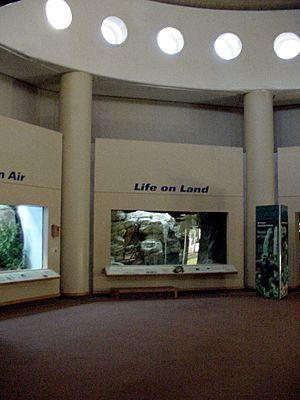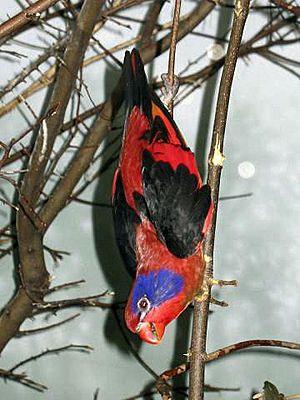Prospect Park Zoo facts for kids

Prospect Park Zoo logo
|
|
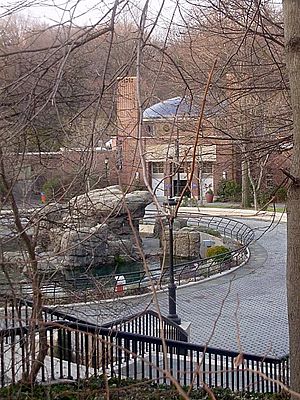 |
|
| Date opened | 1890 (a menagerie); July 3, 1935 (city zoo); October 5, 1993 (wildlife conservation center) |
|---|---|
| Location | 450 Flatbush Avenue, Brooklyn, New York, United States 11225, in Prospect Park |
| Land area | 12 acres (4.9 ha) |
| Coordinates | 40°39′57″N 73°57′52″W / 40.66583°N 73.96444°W |
| No. of animals | 864 (2016) |
| No. of species | 176 (2016) |
| Memberships | AZA |
The Prospect Park Zoo is a fun and educational zoo located in Prospect Park in Brooklyn, New York City. It covers about 12 acres and is home to many different animals. As of 2016, the zoo had 864 animals from about 176 different species. Around 300,000 people visit the zoo every year!
The Wildlife Conservation Society (WCS) runs the Prospect Park Zoo. They do more than just care for animals. The WCS also offers cool programs for kids, works to save endangered animals, and even has a wildlife theater. They also connect with the local community through volunteer programs.
The zoo started as a small collection of animals called a "Menagerie" in 1890. The zoo we know today first opened on July 3, 1935. It was part of a big plan to make city parks and zoos better. Many people worked on building it during a tough economic time.
After many years, the zoo closed in 1988 for a huge makeover. It cost $37 million to rebuild almost everything inside. The outside of the old buildings from the 1930s were kept, but everything else was new. The zoo reopened on October 5, 1993. It became part of a group of four zoos and one aquarium managed by the WCS. All these places are approved by the Association of Zoos and Aquariums (AZA).
Contents
Discovering the Prospect Park Zoo
The Prospect Park Zoo is part of the Wildlife Conservation Society's amazing network. This network includes four zoos and an aquarium across New York City. You can find the zoo at 450 Flatbush Avenue, right across from the Brooklyn Botanic Garden. The zoo sits a bit lower than the street level inside Prospect Park. You can enter from Flatbush Avenue or from inside Prospect Park.
In 2016, the zoo had 864 animals from 176 different species. It's a great place to see animals from all over the world!
Exciting Animal Exhibits
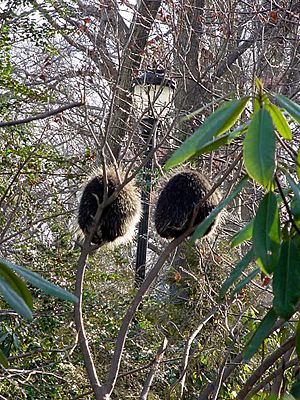
The zoo has three main areas where you can see animals. Each area is in its own special building.
World of Animals
The World of Animals is in the southern part of the zoo. It features the Discovery Trail. This trail starts inside the World of Animals building. Then, you walk outside on a path that goes through the southern part of the zoo. Here, you'll see animals from many different places around the world. They live in settings that look a lot like their natural homes.
On the trail, you might spot black-tailed prairie dogs, porcupines, red pandas, emus, dingos, and North American river otters. Signs often ask fun questions to make you think. You might also look for clues that animals live nearby. In one part of the Discovery Trail, kids can even crawl through "underground burrows." These tunnels lead to clear domes where you can pop up and see prairie dogs right next to you!
Animal Lifestyles
Animal Lifestyles is in the western part of the zoo. This building has indoor exhibits that show how animals live. When you enter, you'll see displays about "Life in the Water," "Life in Air," and "Life on Land." Each display has a special environment with certain animals. These main exhibits help you understand how animals fit into their surroundings.
From the main area, you can explore other exhibits. These might feature Pallas's cats, cotton-top tamarins, meerkats, emerald tree boas, dwarf mongooses, and desert monitors. Some of these animals are critically endangered. The Prospect Park Zoo helps by breeding these species. This is part of the Wildlife Conservation Society's bigger plan to help animals recover in the wild.
A main part of the Animal Lifestyles exhibit is a group of hamadryas baboons. You can watch them in a large area with glass walls. This area looks out onto a rocky space. The baboons can go into small caves that lead to indoor burrows. This helps them stay warm or cool. On the wall, you can learn about how baboons communicate and act. There's plenty of seating so you can relax and watch the baboon family.
Animals in Our Lives
Animals in Our Lives is in the northern part of the zoo. It has both indoor and outdoor exhibits. These shows how animals and people interact. They also show how animals adapt to survive. One part of the building is about "Animals in Art." Here, you can get drawing supplies and learn to sketch wildlife. You'll see animals that have been famous in art for ages. Other exhibits show the natural beauty of different species.
Another part of the building shows how animals use their bodies to survive. You'll learn how colors help animals attract mates, hide, or warn others. There's also a small area for animals that are active at night.
Further north of the building, there's a small working barn. This is part of the Animals in Our Lives exhibit. It has farm animals like sheep, cows, goats, ducks, and geese.
Learning and Helping at the Zoo
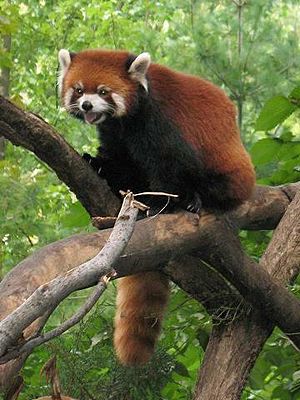
The zoo is not just for seeing animals; it's also for learning! The Discovery Center has classrooms and labs. These are designed to teach school-aged kids how wildlife scientists study animals and the environment. Kids can learn about and use real lab equipment. They also learn how to use what they see to understand animal behavior. These programs are based on ideas from the Bronx Zoo's WIZE (Wildlife Inquiry through Zoo Education) program.
The volunteer program at the Prospect Park Zoo is for adults in the community. It helps people learn and get involved. Volunteer guides give tours to visitors. Volunteer "docents" help with the educational programs. Docents go through a four-month training program. After they finish, they help staff with demonstrations and explaining exhibits.
Zoo Layout and Buildings
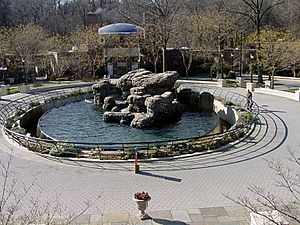
The zoo's buildings were designed by Aymar Embury II. There are six red brick buildings with limestone details. They are arranged in a half-circle around a central courtyard. The sea lion pool is right in the middle of this courtyard. The outside of these buildings looks like they did in the 1930s. But the insides were completely rebuilt between 1989 and 1993. There's also a wooden barn north of the main buildings.
When you enter, stairs lead you down to the zoo level. A small restaurant and the main office are to your left. The Discovery Center is to your right. In front of you are the three main exhibit buildings: The World of Animals, the Animal Lifestyles building (behind the sea lion pool), and Animals in Our Lives. You can explore the exhibits in any order you like!
History of the Zoo
Early Animal Collections
Back in 1866, there was a plan for a "Zoological Garden" in Prospect Park. But it wasn't built then. However, some parts of the park did have animals. There was a Wild Fowl Pond for water birds. There was also a Deer Paddock, a fenced area for deer. Sheep also helped keep the grass trimmed in the park meadows.
Interest in zoos grew in the late 1800s. In 1890, an informal "Menagerie" (animal collection) started in Prospect Park. It grew mostly from animals donated by wealthy people. By 1893, the collection included seals, a buffalo, foxes, bears, a sacred cow, deer, and peacocks.
These animals were kept in pens on Sullivan Hill, across from where the zoo is now. The deer from the Deer Paddock were moved there. The Wild Fowl Pond also remained. The Menagerie kept growing in the early 1900s. A two-story brick building opened in 1916 for monkeys, small mammals, and birds.
Building the Modern Zoo
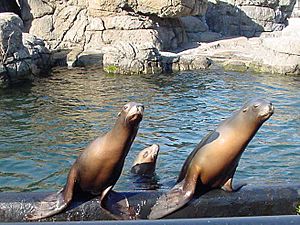
In 1934, New York City Mayor Fiorello La Guardia asked Robert Moses to lead the city's Parks Department. Moses made big plans to rebuild city parks, including new zoos. He got a lot of money and workers to help. This helped many people find jobs during the Great Depression.
Plans for the new Prospect Park Zoo were announced in March 1934. The new zoo was built where the Wild Fowl Pond and old Deer Paddock used to be. Architect Aymar Embury II designed a half-circle of six brick buildings around a seal pool. The buildings were made of red brick with limestone. They even had cool carvings from Rudyard Kipling's The Jungle Book on their walls.
Five sculptors created thirteen of these scenes on the buildings and at the entrances. The new zoo opened on July 3, 1935. It was a huge improvement over the old Menagerie. It had a bear pit, a seal pool, a lion's house (now the Animals in Our Lives building), an elephant's house (now Animal Lifestyles), and a house for monkeys, birds, and horned animals (now World of Animals). The old Menagerie area was then turned back into forest land.
Changes and Renovation
For the next 50 years, the zoo showed off large animals from far-off places. Many people visited, but over time, the zoo started to get old and worn out. It needed a lot of repairs.
So, in June 1988, the Prospect Park Zoo closed. All the animals found new homes in other zoos. Then, a big renovation project began in 1989. It took almost five years and cost $37 million! The outside of the old buildings were saved, but the insides were completely redone. Old pits and cages were removed, and new structures were built.
The zoo was given to the New York Zoological Society (now the Wildlife Conservation Society) in 1993. The Society wanted each of its smaller zoos to have a special focus. The Prospect Park Zoo was planned to be mainly a children's zoo.
The renovated zoo reopened on October 5, 1993. It was renamed the "Prospect Park Wildlife Conservation Center." The new name was meant to show that it was more than just a zoo; it was a place to help save animal species. This name change happened at the same time the Zoological Society changed its name to the "Wildlife Conservation Society."
The new center focused on teaching children. Classrooms for the Discovery Center were in a special building. The exhibits featured smaller animals, instead of elephants, tigers, and lions. They also added interactive displays. Even with the new name, people still called it "The Prospect Park Zoo." Over time, the old name stuck, and even the WCS uses "Prospect Park Zoo" now.
Keeping the Zoo Open
Running a zoo costs a lot of money. The Wildlife Conservation Society gets money from private donations and from the city. Sometimes, there are money problems. For example, in 2003, the city faced a big budget problem. The Mayor suggested cutting all city money for the Prospect Park Zoo and the Queens Zoo. These were the smallest zoos run by the WCS and had fewer visitors than the Bronx Zoo or Central Park Zoo.
For a few months, no one knew if the zoos would stay open. But then, the city and the City Council worked together. They found that it would actually cost more money to close the zoos than to keep them running! So, the budget was approved with some money for the zoos. To keep them open, the WCS had to make some changes. They closed some classroom programs and increased admission fees.
Later, funding levels for the WCS were restored. But zoos always need support to keep their animals healthy and their programs running.


